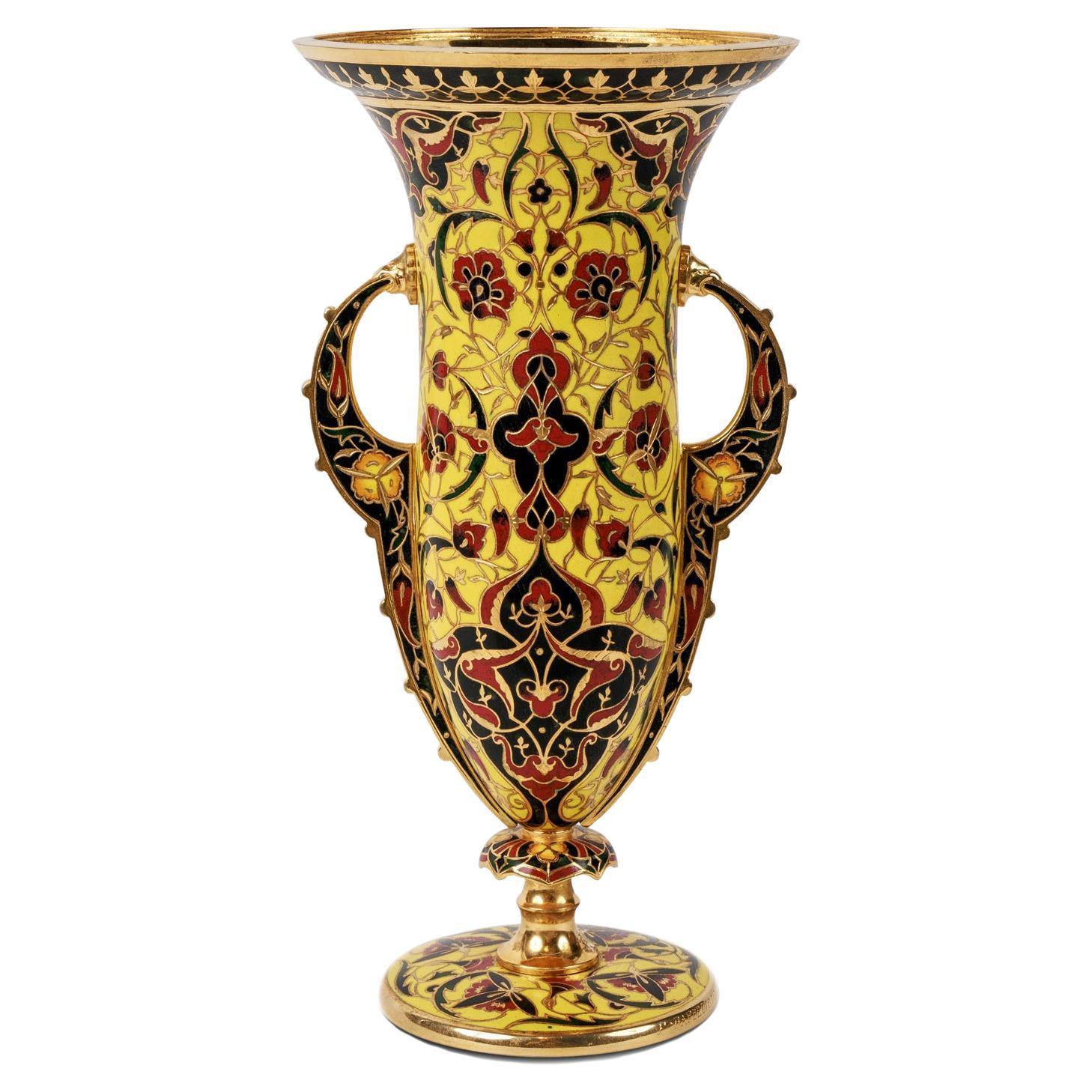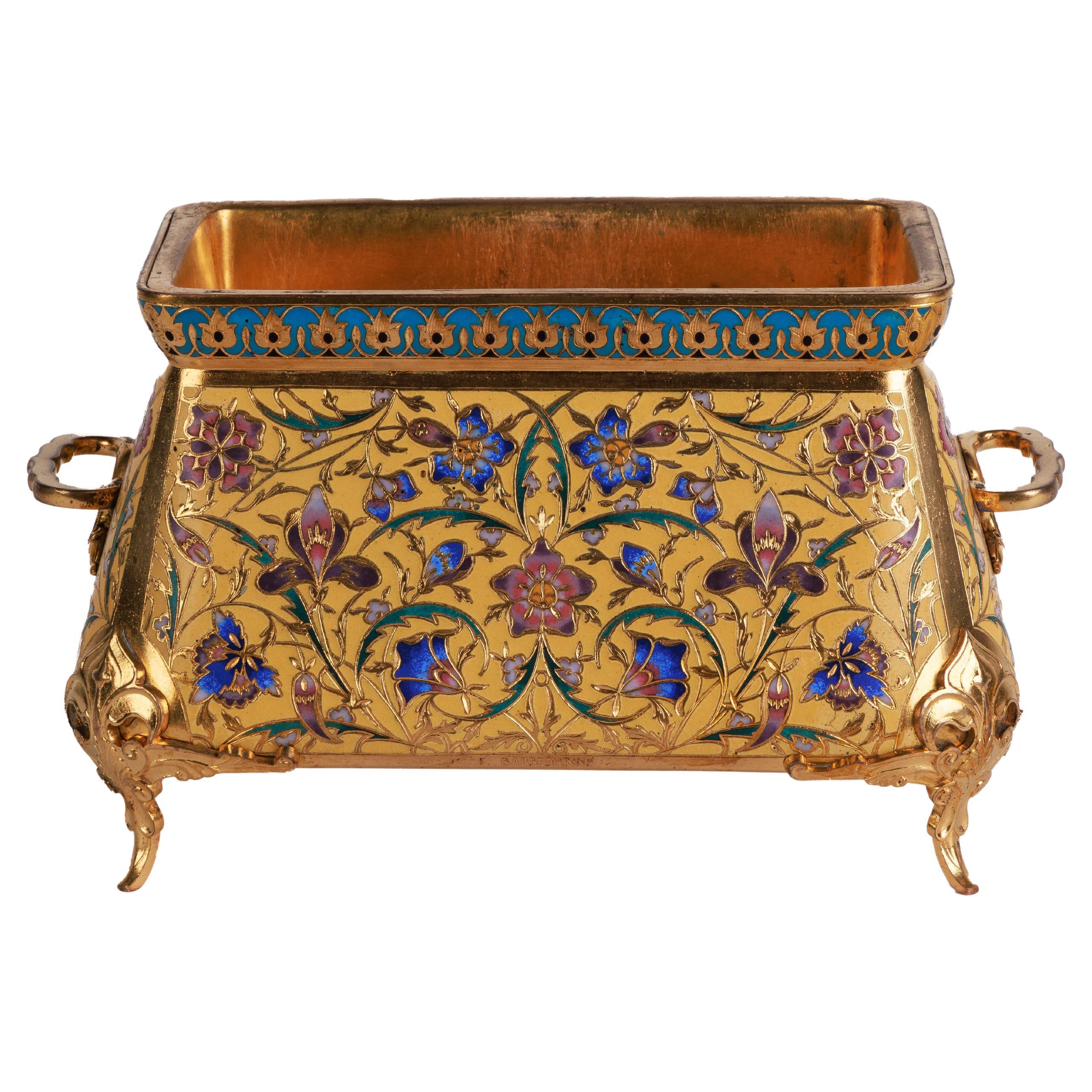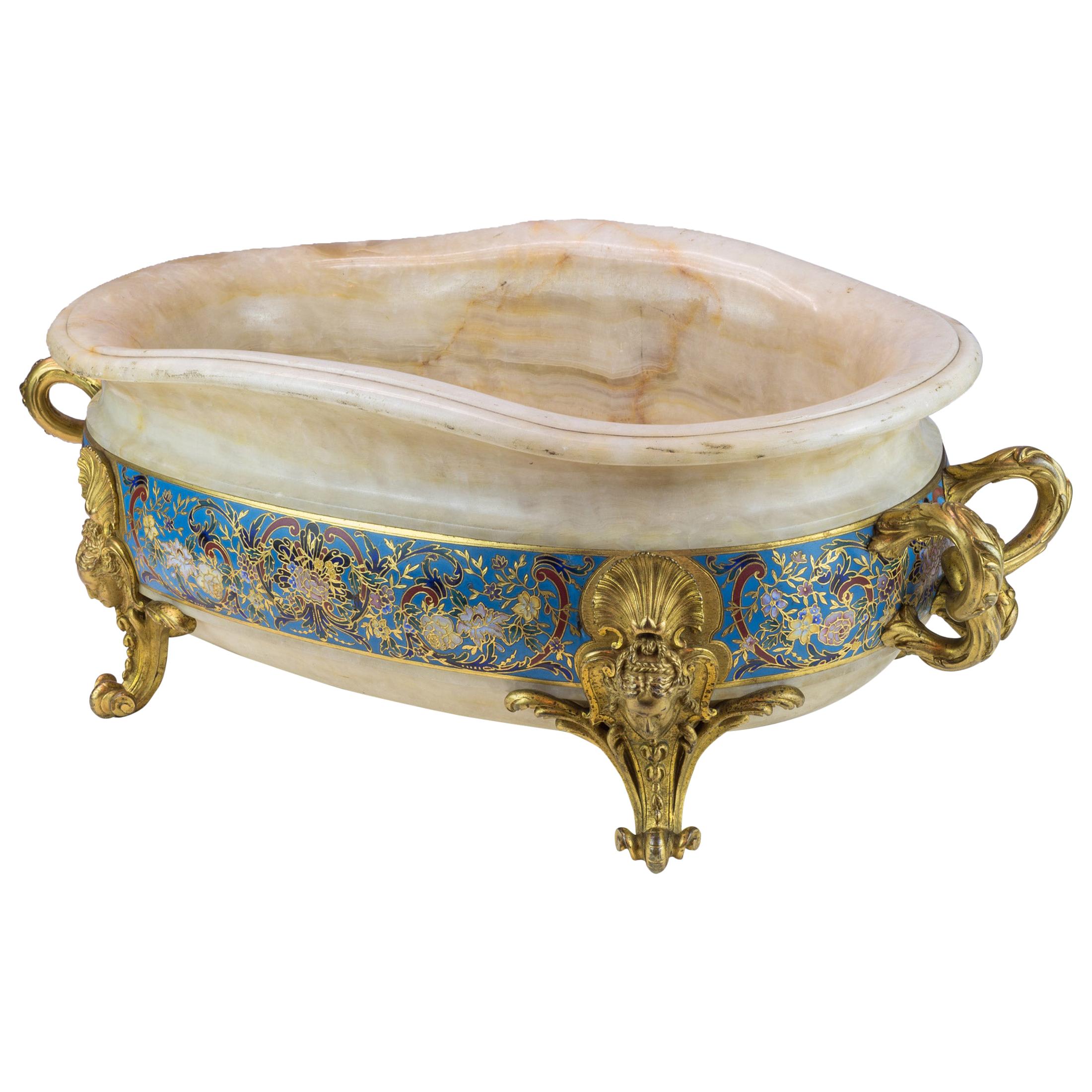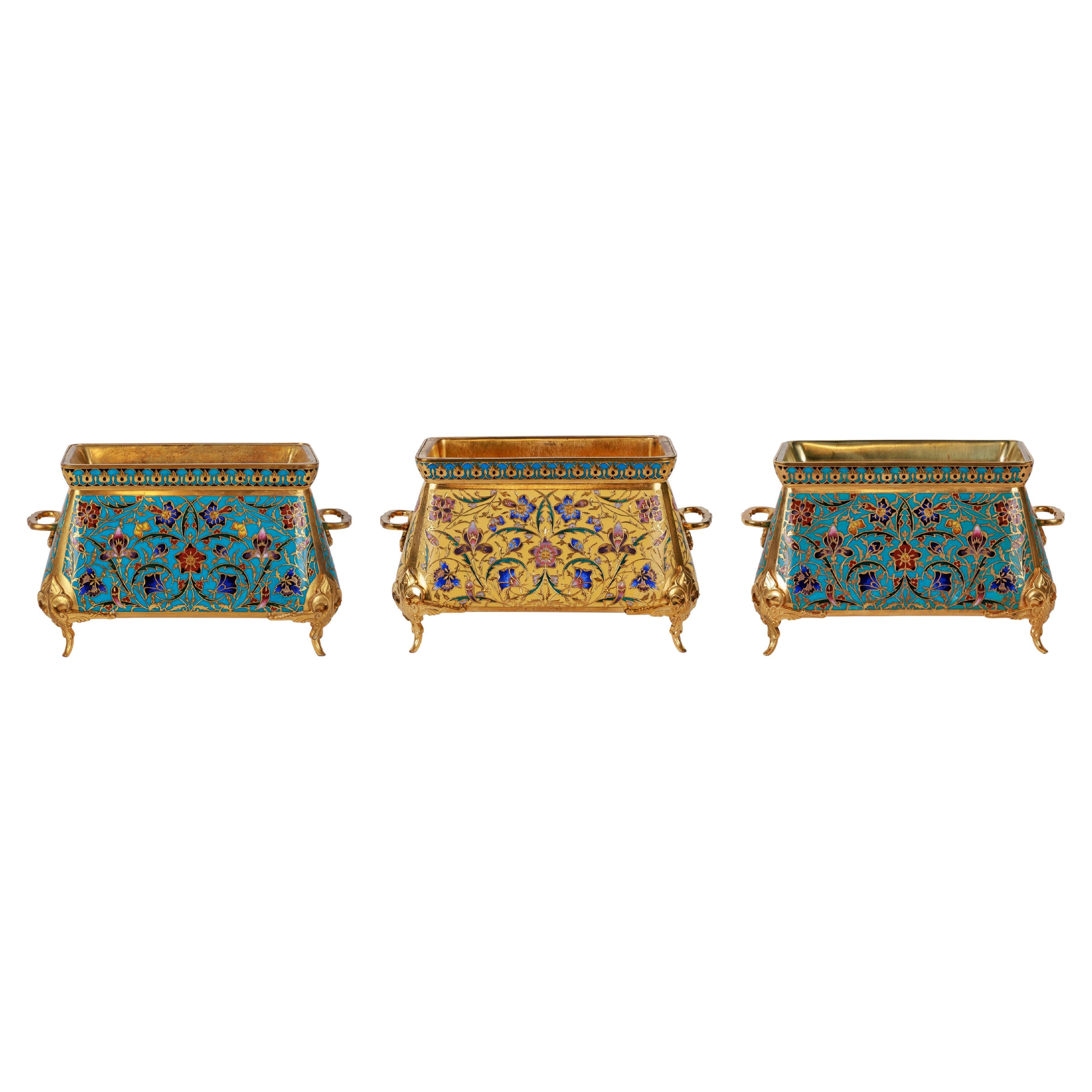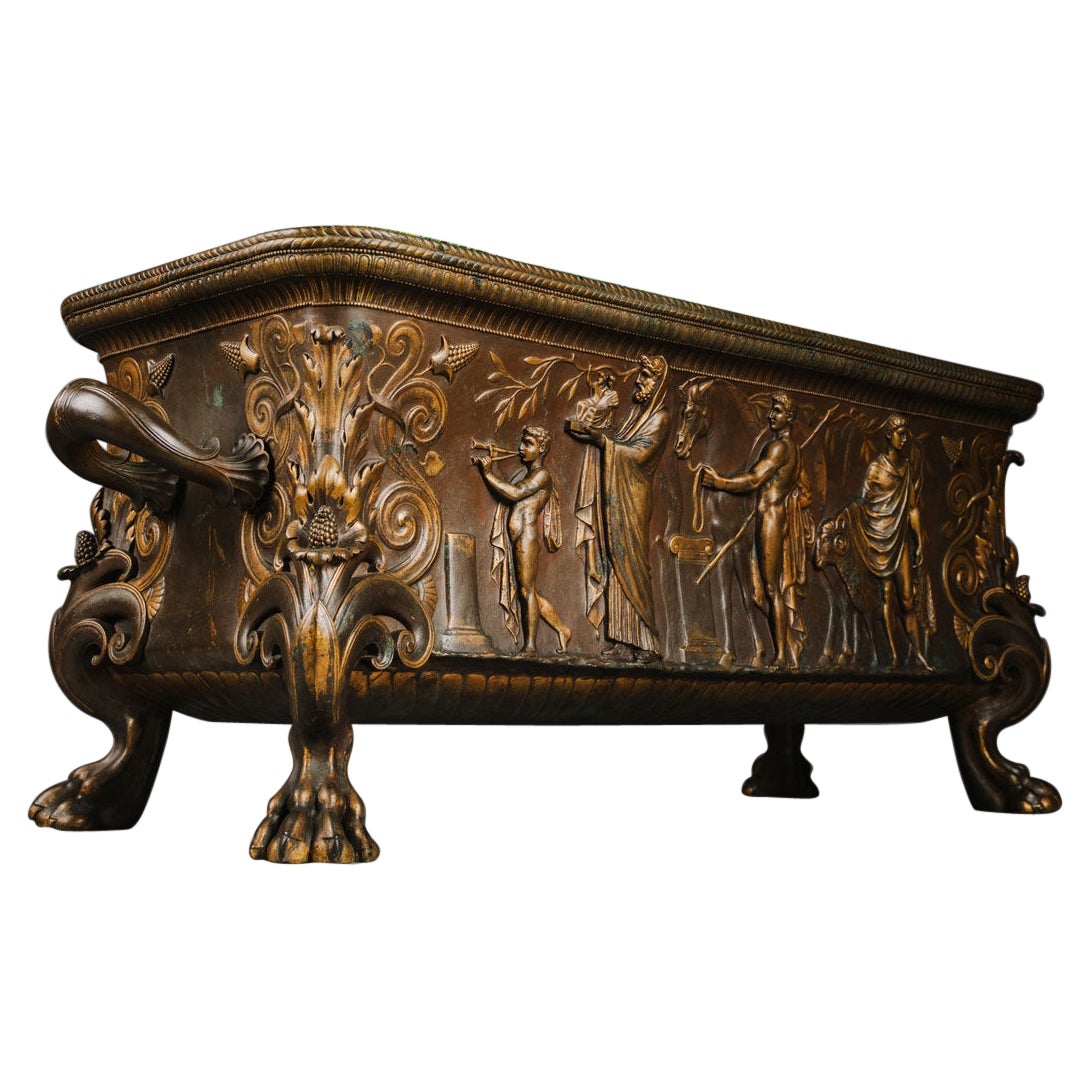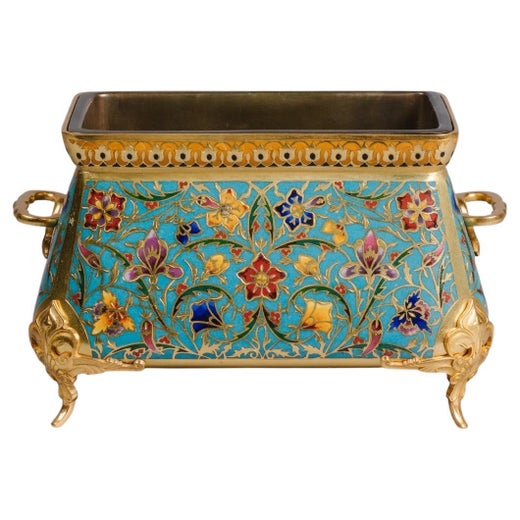A Champlevé Enamel Jardinière by Ferdinand Barbedienne
About the Item
- Creator:Ferdinand Barbedienne (Manufacturer),Louis-Constant Sevin (Designer)
- Dimensions:Height: 5.52 in (14 cm)Width: 9.45 in (24 cm)Depth: 5.91 in (15 cm)
- Materials and Techniques:
- Place of Origin:
- Period:
- Date of Manufacture:Circa 1870
- Condition:Wear consistent with age and use.
- Seller Location:Brighton, GB
- Reference Number:
Louis-Constant Sevin
Best known for his work at the leading bronze foundry Maison Barbedienne in 1855, award-winning French ornamentalist Louis-Constant Sévin created awe-inspiring decorative objects worthy of the most prestigious houses of European royalty.
Born into a creative family in 1821, Sévin studied design and sculpture under Parisian artist Antoine-André Marneuf at the age of 13. In 1839, Sévin left to collaborate with sculptors Phénix and Joyau and design for famous silversmiths François-Désiré Froment-Meurice and Henri Duponchel. He then moved to London in order to evade the 1848 revolution, where he worked with goldsmith Léonard Morel-Ladeuil to design pieces that were showcased at the Great Exhibition of 1851.
Sévin returned to France that year to design models for Jouhanneaud and Dubois — a porcelain factory in the celebrated Limoges region of France — before commencing what became his decades-long position as an ornamental sculptor with Ferdinand Barbedienne.
For 23 years, Sévin created lamps, mirrors, boxes and more at Maison Barbedienne, which was one of the most revered foundries in 19th-century France, where its proprietor used electroplating to create ormolu. Working alongside chaser Désiré Attarge, Sévin designed Napoleon III-era works that greatly appealed to European nobility, and both kings of Belgium and Holland, Her Majesty the Queen of England, Madame de Païva and the Kremlin all awarded him commissions — this included his work for the final resting place of Prince Albert at Frogmore House in Windsor.
Sévin gravitated toward ancient Greek motifs and his work often mimicked the ornate detailing associated with design in China and the Middle East. An extraordinary cabinet that features Moorish-style arches is held in the collection of the Metropolitan Museum of Art, while his decorative clock designs, such as the neo-Renaissance-style model that earned Barbedienne the Grand Prix in 1878, are especially demonstrative of Sévin’s talent for creating objects with rich cultural significance.
On 1stDibs, find a collection of antique Louis-Constant Sévin lighting and decorative objects.
Ferdinand Barbedienne
Founded by one-time Parisian wallpaper dealer Ferdinand Barbedienne and engineer Achille Collas, one of the most revered foundries in 19th-century France began with the invention of a revolutionary 1830s-era device that could produce proportional reproductions — large or small — of sculptures. Collas’s machine, which yielded miniature likenesses of antiquities for the interiors of homes the world over, was pivotal to the success of the F. Barbedienne Foundry. The successful firm earned prestigious awards and critical acclaim and created exquisite bronze candleholders, clocks and lamps for a range of wealthy and prominent clients.
The duo first launched their company under the name Société Collas et Barbedienne, and early on, they optimized chemical processes for pigmenting and patinating their bronze statuettes. After Collas died in 1859, Barbedienne forged on alone, and the company’s name changed to simply F. Barbedienne.
Barbedienne employed more than 300 workers at that point, and the Maison created a range of furnishings and decorative objects that featured the integration of marble and ormolu accents. However, with the onset of the Franco-Prussian War of 1870, the foundry was forced to retrofit its molds, and the production of cannons replaced sculptures, furniture and vases.
When Ferdinand Barbedienne passed away in 1891, his nephew and heir, Gustave Leblanc, took over as president, changing the name to Leblanc-Barbedienne. Leblanc expanded production into Germany, the United Kingdom and the United States, carrying on the company's legacy with monumental sculptures, and models and securing production rights for famous statues. Paul-Alexandre Dumas, an Art Nouveau maker and student of Louis Majorelle, succeeded Leblanc until the company's closing in 1952.
Barbedienne pieces had been exhibited regularly in the 19th century and were especially prevalent at Europe’s international expositions and world’s fairs, where they received numerous prizes. Today, the Musée d’Orsay in Paris holds dozens of Barbedienne works in its collection, including intricate mirrors, vases and cups created by Louis-Constant Sévin at the foundry. For more than two decades, Sévin created lamps, boxes and more at Maison Barbedienne. Working alongside award-winning chaser Désiré Attarge, Sévin designed Napoleon III-era works that greatly appealed to European nobility.
Other notable artists who collaborated with Barbedienne included Eugene Aizelin, Emmanuel Fremiet, Antonin Mercié, Emile Guillemin, Edouard Lievre, Ferdinand Levillain and Auguste Rodin.
On 1stDibs, find a collection of antique Ferdinand Barbedienne decorative objects, lighting and more.
- ShippingRetrieving quote...Ships From: Brighton, United Kingdom
- Return PolicyA return for this item may be initiated within 7 days of delivery.
- Large and Finely Cast Neo-Grec Jardinière by Ferdinand BarbedienneBy Ferdinand BarbedienneLocated in Brighton, West SussexA large and finely cast neo-grec gilt and patinated bronze jardinière by Ferdinand Barbedienne. Signed 'F. BARBEDIENNE'. This rare Jardinière or ...Category
Antique 19th Century French Neoclassical Revival Planters, Cachepots and...
MaterialsBronze
- Chinese-Style Porcelain Vase In The Manner of Ferdinand BarbedienneBy Ferdinand BarbedienneLocated in Brighton, West SussexA Gilt-Bronze Mounted Chinese-Style Porcelain Vase With Dragon Handles and Elephant Head Feet, In the Manner of Ferdinand Barbedienne. Frenc...Category
Antique 19th Century French Chinoiserie Vases
MaterialsOrmolu
- Pair of Gilt and Patinated Bronze Candelabra by Ferdinand BarbedienneBy Paul Dubois, Ferdinand BarbedienneLocated in Brighton, West SussexA Pair of Gilt and Patinated Bronze Figural Five-Light Candelabra Cast by Barbedienne after the Models by Alexandre Falguière and Paul Dubois. Signed ‘FALGUIERE’ and ‘P. DUBOIS’ ...Category
Antique 19th Century French Torchères
MaterialsBronze
- Neoclassical Style Gilt-Bronze Gueridon Attributed to Ferdinand BarbedienneBy Ferdinand BarbedienneLocated in Brighton, West SussexAn unusual neoclassical style gilt bronze Gueridon with an inlaid black marble top, in the manner of Ferdinand Barbedienne and Louis-Constant Sévin. This unusual Gueridon has a ci...Category
Antique 1860s French Neoclassical Revival Gueridon
MaterialsBelgian Black Marble
- Fine Gilt-Bronze and Champlevé Enamel Garniture Set, circa 1890Located in Brighton, West SussexA fine gilt bronze and Champlevé Enamel Garniture Set comprising a pair of candelabra and a brûle-parfum and cover. French, circa 1890. The brûle -parfum or censor with a domed champlevé enamel lid above a gilt bronze pierced guilloche border with ram's head mounts supported by a baluster column flanked by seated putti finely cast with musical instruments on a circular base. The candelabra en suite having a pair of of putti figures supporting candlearms with circular champlevé enamel drip trays and sconces. Champlevé enamelling, is similar to cloisonné in that the enamel is applied to discrete cells separated by metal. However, in champlevé, cells or troughs are cast into or cut away from the metal base, leaving a raised metal line between the cells which forms the outline of a design. The cells are then filled with molten or powdered glass and fired. Height of central vase: 25 cm Width of central vase: 15 cm...Category
Antique Late 19th Century French Louis XVI Vases
MaterialsEnamel, Bronze
- Napoleon III Clock Garniture Designed by Sévin, Cast by BarbedienneBy F. Barbedienne Foundry, Louis-Constant SevinLocated in Brighton, West SussexA fine Napoleon III gilt-bronze and porcelain mounted clock garniture, designed by Louis-Constant Sévin, cast by Ferdinand Barbedienne, The Movement by Japy Frères. Frédéric Japy ...Category
Antique 19th Century French Napoleon III Mantel Clocks
MaterialsOrmolu
- Ferdinand Barbedienne, a French Ormolu and Champleve Enamel Jardiniere, C. 1870By Ferdinand Barbedienne, Louis-Constant SevinLocated in New York, NYFerdinand Barbedienne, A French Ormolu and Champleve Enamel Jardiniere, C. 1870, The Design Attributed to Louis Constant Sevin. An exceptional qualit...Category
Antique 19th Century French Napoleon III Decorative Bowls
MaterialsBronze, Ormolu, Enamel
- Extremely Rare Pair of Ferdinand Barbedienne Ormolu and Champlevé Enamel VasesBy Louis-Constant Sevin, Ferdinand BarbedienneLocated in New York, NYAn extremely rare, museum quality pair of Ferdinand Barbedienne ormolu and champlevé enamel vases, circa 1870, certainly designed by Louis Constant Sevin...Category
Antique 19th Century French Napoleon III Vases
MaterialsEnamel, Ormolu
- Ferdinand Barbedienne, A French Ormolu and Champleve Enamel Vase, C. 1870By Ferdinand BarbedienneLocated in New York, NYFerdinand Barbedienne, A French Ormolu and Champleve Enamel Vase, C. 1870 In the Islamic / Alhambra taste. The two handled vase in Alhambra form, enameled in rich yellow throughout ...Category
Antique 19th Century French Napoleon III Vases
MaterialsBronze, Enamel, Ormolu
- Ormolu-Mounted and Champlevé Enamel Decorated Onyx Jardinière by BarbedienneBy Ferdinand BarbedienneLocated in New York, NYA fine quality large Neo-Grec gilt bronze-mounted and Champlevé enamel decorated onyx Jardinière by F. Barbedienne Maker: Ferdinand Barbedienne (181...Category
Antique Mid-19th Century French Planters, Cachepots and Jardinières
MaterialsOnyx, Bronze, Enamel
- F. Barbedienne, A Suite of Three French Ormolu and Champleve Enamel JardinieresBy Ferdinand BarbedienneLocated in New York, NYFerdinand Barbedienne, An Exquisite Suite of Three French Ormolu and Champleve Enamel Jardinieres / Garniture C. 1870, The Design Attributed to Louis Constant Sevin. Comprising of t...Category
Antique 19th Century French Napoleon III Planters, Cachepots and Jardini...
MaterialsBronze, Enamel, Ormolu
- 19th Century Silvered Bronze Athénienne Jardinière by Ferdinand BarbedienneBy Ferdinand BarbedienneLocated in Oxfordshire, United KingdomA French silvered-bronze athénienne by Ferdinand Barbedienne, Paris, last quarter 19th century with a revolving liner, the frieze applied with bucrania suspending ribbon-tied berried laurel swags above a border of bellflowers on a stippled ground above three seated female sphinxes issuing stylised foliage and scrolls on lion monopodia cast with the mask of Hercules, scrolling foliage and anthemions joined by stretchers, raised on a concave-sided triform marble base on a further thin silvered-bronze base, inscribed to the tripod base 'F. BARBEDIENNE' Measures: 103.3cm. high, 41.5cm. diameter; 3ft. 4 3/8 in, 1ft. 4 1/4. This impressive athénienne is a key reminder of the longevity of a particular model and design’s success from Antiquity through to the 19th century and up until this day. Typically known as the ‘Trépied du Temple d’Isis’, this athénienne is designed after the Roman antique originally found at Pompeii and now at the Museo Archeologico Nazionale, Naples (fig.1). From being for example an inspiration for the baptismal font of Napoléon’s son in 1811, this model was the inspiration to many highly skilled makers throughout the 19thcentury such as the Manfredini brothers from Milan and of course the Parisian well-established bronze founder Ferdinand Barbedienne who executed the present example. The Temple of Isis was a Roman temple dedicated to the Egyptian goddess Isis and was among one of the first discoveries during the excavation of Pompeii in 1764. Certainly considered as one of the most elegant examples of antique tripods, the existence of this model was then popularized to the rest of Europe via prints, one of the first being by Giovanni Battista Piranesi in 1779. This type of tripod was also popularised by an engraving in C. Percier and P. Fontaine’s, Receuil de Décorations Intérieures of 1801. Interestingly, there is also a watercolour now in the Musée Carnavalet, Paris, showing this type of tripod displayed at the 1801 Exposition des Produits de L’Industrie in the Louvre. The passion for Greek and Roman Art in the 19th century. The discovery of Pompeii and Herculaneum around the middle of the 18th century gave rise to a new passion for Antiquity and the excavated masterpieces renewed the repertoire of fine and decorative arts and served as models for Neoclassicism. Members of the aristocracy as well as connoisseurs, particularly in England, completed their education by undertaking a ‘Grand Tour’ of Italy and often fell victim to the recently unearthed Greek and Roman artefacts...Category
Antique 19th Century French Grand Tour Planters, Cachepots and Jardinières
MaterialsMarble, Silver Plate, Bronze
